7.2 Water Supply Problems and Solutions
Section Goals:
- Understand water use throughout the world.
- Understand the impact of groundwater drawdown on soil and land.
- Consider sustainable ways to ensure fresh water availability to all people.
Water Use in the U.S. and World
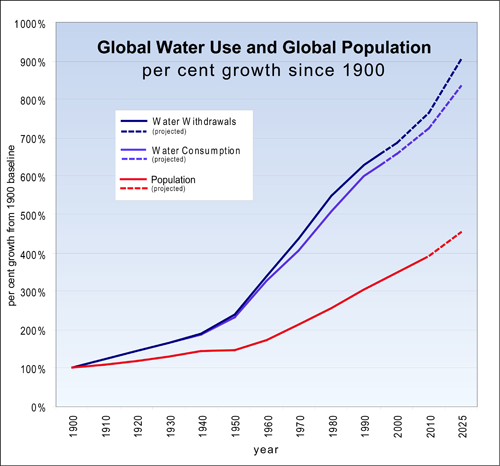
People need water, oftentimes large quantities, to produce the food, energy, and mineral resources they use. Consider, for example, these approximate water requirements for some things people in the developed world use every day: one tomato = 3 gallons; one kilowatt-hour of electricity from a thermoelectric power plant = 21 gallons; one loaf of bread = 150 gallons; one pound of beef = 1,600 gallons; and one ton of steel = 63,000 gallons. Human beings require only about 1 gallon per day to survive, but a typical person in a U.S. household uses approximately 100 gallons per day, which includes cooking, washing dishes and clothes, flushing the toilet, and bathing. The water demand of an area is a function of the population and other uses of water.
Global total water use is steadily increasing at a rate greater than world population growth; almost double the rate (Figure 1). During the 20th century global population tripled and water demand grew by a factor of six. The increase in global water demand beyond the rate of population growth is due to improved standards of living without an offset by water conservation. Our society relies on water for agriculture and industrial production; therefore increased production of goods and energy entails a large increase in water demand. The major global water uses are irrigation (68%), public supply (21%), and industry (11%).
Where has this “extra” water come from to meet the rising demand? Most often, from groundwater. Groundwater is calculated to be the most accessed source of freshwater around the world. Groundwater accounts for about half of the world’s drinking water, 40% of its irrigation water, and a third of water for industrial purposes.
Water Supply Problems: Resource Depletion
Rivers, lakes, and artificial lakes (reservoirs) can also be depleted due to overuse. Some large rivers, such as the Colorado in the U.S. and Yellow in China, run dry in some years. The case history of the Aral Sea discussed later in this chapter involves irreparable depletion of an inland sea. Glaciers are being depleted due to accelerated melting associated with global warming over the past century.
Of primary concern, though, is the depletion of groundwater. It may be hard to imagine water as a minable resource, but the fact is that groundwater aquifers have formed over geological timescales rather than human timescales. Groundwater flows, similar to surface water, but much more slowly. It can take years or decades for water to move through an aquifer. Groundwater mining is defined as a water resource depletion that occurs when withdraw rates are higher than the rate of recharge. Groundwater mining can be due to a large number of wells installed in the area. It causes the regional water table to drop significantly, which can force the drilling of deeper, more expensive wells. What occurs at a local scale highlights the issue: As groundwater is pumped from water wells, a localized drop in the water table around the well forms, called a cone of depression (Figure 2).
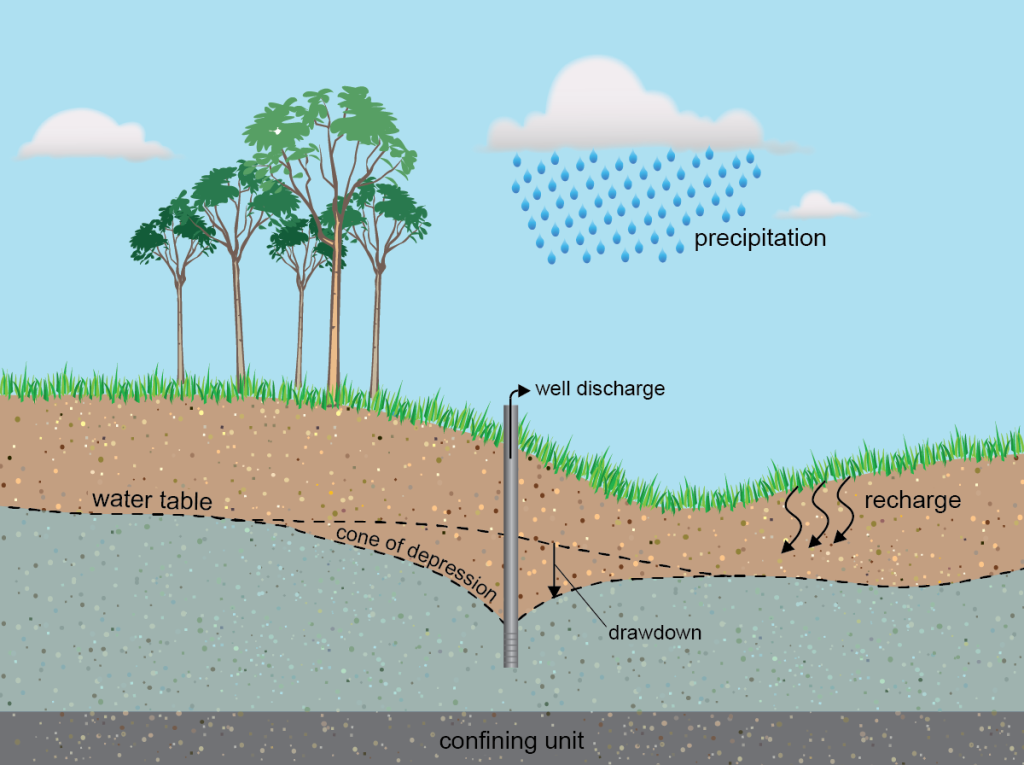
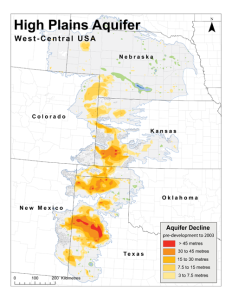
Finally, problems of subsidence (gradual sinking of the land surface over a large area) and sinkholes (rapid sinking of the land surface over a small area) can develop due to a drop in the water table. Subsidence occurs when too much water is pumped out from underground, deflating the space below the above-surface, and thus causing the ground to collapse. The result can look like craters on plots of land. This occurs because, in its natural equilibrium state, the hydraulic pressure of groundwater in the pore spaces of the aquifer supports some of the weight of the overlying sediments. When groundwater is removed from aquifers by excessive pumping, and the water is not replaced quickly enough, pore pressures drop in the aquifer, and compression of the mineral component of the aquifer will occur. In the middle United States, where groundwater has been heavily exploited (Figure 3), land subsidence has caused a drop in the land surface of two to ten feet (Figure 4).
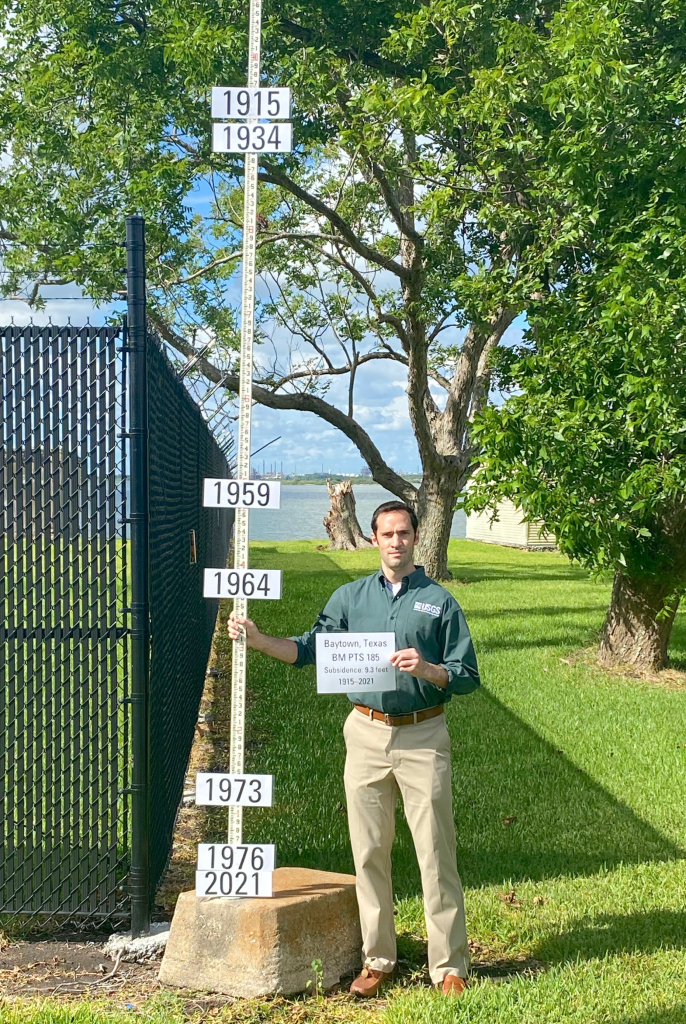
The final water resource problem associated with groundwater mining is intrusion of saltwater or pollution into what was previously clean fresh water. Both issues are caused by a change in the direction of flow due to a cone of depression in an unconfined aquifer. Saltwater intrusion specifically occurs when aquifers near ocean coastlines are over-drawn. Saltwater enters freshwater zones because the freshwater water table drops below the saltwater table. In areas where pollution is a concern, over-drawn wells can reverse the flow of the local groundwater, causing pollution to flow toward the pumping well.
Water Supply Crisis
The water crisis refers to a global situation where people in many areas lack access to sufficient water, clean water, or both. This section describes the global situation involving water shortages, also called water stress. In general, water stress is greatest in areas with very low precipitation (major deserts), large population density (e.g., India), or both. Future global warming could worsen the water crisis by shifting precipitation patterns away from humid areas and by melting mountain glaciers that recharge rivers downstream. Melting glaciers will also contribute to rising sea level, which will worsen saltwater intrusion in aquifers near ocean coastlines.
According to a 2006 report by the United Nations Development Programme, 700 million people (11% of the world’s population) lived with water stress (Figure 5). Most of them live in the Middle East and North Africa. By 2025, the report projects that more than 3 billion people (about 40% of the world’s population) will live in water-stressed areas with the large increase coming mainly from China and India. The water crisis will also impact food production and our ability to feed the ever-growing population. We can expect future global tension and conflict to arise associated with water shortages and pollution. Historic and future areas of water conflict include the Middle East (Euphrates and Tigris River conflict among Turkey, Syria, and Iraq; Jordan River conflict among Israel, Lebanon, Jordan, and the Palestinian territories), Africa (Nile River conflict among Egypt, Ethiopia, and Sudan), Central Asia (Aral Sea conflict among Kazakhstan, Uzbekistan, Turkmenistan, Tajikistan, and Kyrgyzstan), and south Asia (Ganges River conflict between India and Pakistan).
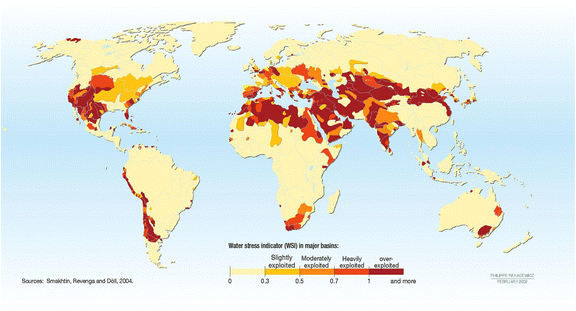
Sustainable Solutions to the Water Supply Crisis?
The current and future water crisis described above requires multiple approaches to extending our fresh water supply and moving towards sustainability. Some of the longstanding traditional approaches include dams and aqueducts.

Reservoirs that form behind dams in rivers can collect water during wet times and store it for use during dry spells. They also can be used for urban water supplies. Other benefits of dams and reservoirs are hydroelectricity, flood control, and recreation (Figure 6). Some of the drawbacks are evaporative loss of water in arid climates, downstream river channel erosion, and impact on the ecosystem including a change upstream from a river to lake habitat, a change downstream to seasonal water temperature and flow, and interference with migration and spawning of fish.
Aqueducts can move water from where it is plentiful to where it is needed. Aqueducts can be controversial and politically difficult especially if the water transfer distances are large. Water diversion can cause drought in the area from where the water is drawn. For example, Owens Lake and Mono Lake in central California began to disappear after their river flow was diverted to the Los Angeles aqueduct (Figure 7). Owens Lake remains almost completely dry, but Mono Lake has recovered more significantly due to legal intervention.
One method that can actually increase the amount of fresh water on Earth is desalination, which involves removing dissolved salt from seawater or saline groundwater. There are several ways to desalinate seawater including boiling, filtration, and electrodialysis. All of these procedures are moderately to very expensive and require considerable energy input, making the water produced much more expensive than fresh water from conventional sources. In addition, the process creates highly saline wastewater, which must be disposed of and creates significant environmental impact. Desalination is most common in the Middle East, where energy from oil is abundant but water is scarce.

Conservation means using less water and using it more efficiently. Around the home, conservation can involve both engineered features, such as high-efficiency clothes washers and low-flow showers and toilets, as well as behavioral decisions, such as growing native vegetation that require little irrigation in desert climates, turning off the water while you brush your teeth, and fixing leaky faucets.
Another important conservation technique is efficient irrigation, which is extremely important because irrigation accounts for a much larger water demand than public water supply. Water conservation strategies in agriculture include growing crops in areas where the natural rainfall can support them, more efficient irrigation systems such as drip systems that minimize losses due to evaporation, no-till farming that reduces evaporative losses by covering the soil, and reusing treated wastewater from sewage treatment plants. Recycled wastewater has also been used to recharge aquifers.
Suggested Supplementary Reading:
Weiss, K.R. 2018. Drying Lakes. National Geographic. March. p. 108-133.
This article documents how many lakes across the globe are drying up, the reasons why, and the effect on humans. Overuse and a warming climate threaten lakes that provide sustenance and jobs for humans, while also providing critical habitat for animals.
Attribution
Essentials of Environmental Science by Kamala Doršner is licensed under CC BY 4.0. Modified from the original by Matthew R. Fisher and Joni Baumgarten.
Groundwater by Wikipedia is licensed CCA-SA 3.0. Accessed February 20, 2023. Modified by Joni Baumgarten.

